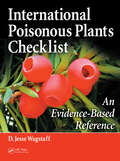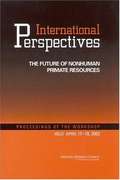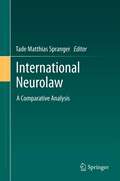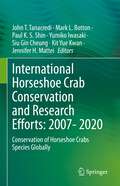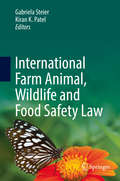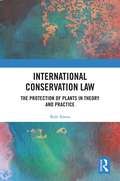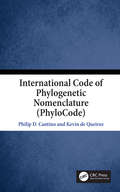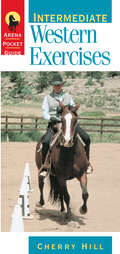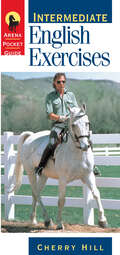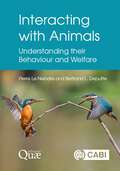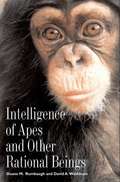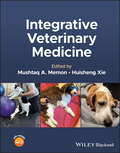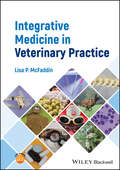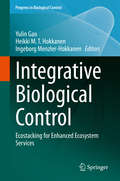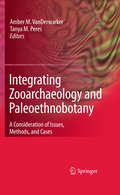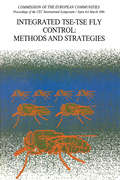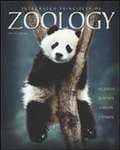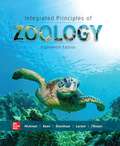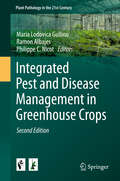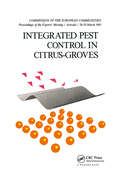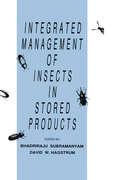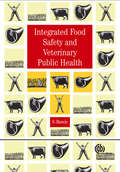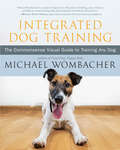- Table View
- List View
International Poisonous Plants Checklist: An Evidence-Based Reference
by D. Jesse WagstaffKnowledge of plant toxicity has always been important, but the information has not always been reliable. Now, increasing international trade is drawing attention to the inadequacy of regional information and highlighting the geographical fragmentation and notorious discrepancies of thinly documented information. The international community of safet
International Perspectives: The Future of Nonhuman Primate Resources
by Institute for Laboratory Animal ResearchThe future of nonhuman primate (NHP) resources is a concern of scientists, veterinarians, and funding authorities. An April 2002 workshop brought participants from all over the world to discuss various aspects of the issue such as current shortfalls and excesses in NHP breeding and exportation programs, the status of breeding and conservation programs internationally, the development of specific pathogen-free colonies, difficulties in transporting NHP, and challenges in the management of NHP colonies.
International Neurolaw
by Tade Matthias SprangerWhereas the past few years have repeatedly been referred to as the "era of biotechnology", most recently the impression has emerged that at least the same degree of attention is being paid to the latest developments in the field of neurosciences. It has now become nearly impossible to maintain an overview of the number of research projects dealing with the functionality of the brain - for example concerning its organizational structure - or projects dealing with the topics of legal responsibility, brain-computer interface applications, neuromarketing, lie detection or mind reading. These procedures are connected to a number of legal questions concerning the framework conditions of research projects as well as the right approach to the findings generated. Given the primary importance of the topic for the latest developments, it is essential to compare the different legal systems and strategies that they offer for dealing with these legal implications. Therefore, the book International Neurolaw - A Comparative Analysis contains several country reports from around the world, as well as those of international organizations such as UNESCO, in order to show the different legal approaches to the topic and possible interactions.
International Horseshoe Crab Conservation and Research Efforts: Conservation of Horseshoe Crabs Species Globally
by Mark L. Botton John T. Tanacredi Siu Gin Cheung Paul K. S. Shin Yumiko Iwasaki Kit Yue Kwan Jennifer H. MatteiThe first International Conference on Horseshoe Crab’s Conservation conducted at Dowling College, USA, (2007) and it’s proceedings published by Springer in 2009, prompted the continued research and conservation efforts presented at subsequent conferences and colloquium in Hong Kong, Taiwan, (2011); San Diego, CA, (2014), (CERF); Japan, Sasebo (2015) and an accepted inclusion for a special session on Horseshoe Crabs at the 2017 CERF Conference held in Providence, RI, USA. All these aforementioned conferences contributed manuscripts, posters, workshop “position papers”, and oral presentations the majority of which have not been published in total. In 2015, Carmichael et al. had published by Springer the majority of manuscripts from the 2011 Hong Kong / Taiwan conference. However, workshop results and all subsequent presentations and workshops were not. The Japan conference presented over 40 papers alone. A collection of all workshop summaries, poster presentations and new manuscript submittals (San Diego, CA; Sasebo, Japan; and Providence, RI) as well as products prepared for the IUCN World Congress in Hawaii, (2016), are included potential contributions for review in this compilation now available for global distribution in this Springer Nature publication.The “Proceedings of International Conferences on the Biology and Conservation of Horseshoe Crabs”, thus contains over 50 manuscripts and a diversified collection of documents, photos and memorabilia covering all four of the horseshoe crab species globally: their biology, ecology evolution, educational, and societal importance. This book exposes the impacts that humans have imposed on all four of these species, revealing through the coordinated effort of horseshoe crab scientists with the IUCN, of the worldwide need for a clear conservative effort to protect these paleo- survival organisms from a looming extinction event. Biologists, conservationists, educators, and health professionals will all welcome this book not only for exploration of its pharmacological interest, but also for the mystery of their longevity. This book also clarifies the future research needs and the conservation agenda for the species worldwide. Anyone working or studying estuaries on a global scale, will need to obtain this seminal work on horseshoe crabs.
International Farm Animal, Wildlife and Food Safety Law
by Gabriela Steier Kiran K. PatelThis volume is an inspiring and breakthrough piece of academic scholarship and the first of its kind featuring a comprehensive reader-friendly approach to teach the intricacies of the various aspects of international farm animal, wildlife conservation, food safety and environmental protection law. The selected focus areas are grouped in sections, such as agrobiodiversity, fishing and aquaculture, pollinators and pesticides, soil management, industrial animal production and transportation, and international food trade. Farm animal welfare, environmental protection, biodiversity conservation, and food safety are the core of the selected chapters. Every chapter provides real-world examples to make the complex field easy to understand. With its systematic approach, this book is devoted to anyone interested in the subject, becomes a valuable resource for professionals working in food regulation, and provides a solid foundation for courses and master's programs in animal law, environmental policy, food and agriculture law, and regulation of these subjects around the world. Through its emphasis on sustainable food production, this work offers a cutting-edge selection of evolving topics at the heart of the pertinent discourse. As one of its highlights, this books also provides "Tools for Change," a unique compilation and analysis of laws from the major farm animal product trading nations. With these tools, practitioners, advocates, policy makers and other state-holders are equipped with information to start work toward improving farm animal welfare, wildlife conservation, and food safety through the use of law and policy.
International Conservation Law: The Protection of Plants in Theory and Practice
by Rob AmosThrough a combination of theoretical and empirical approaches, this book explores the role of international environmental law in protecting and conserving plants. Underpinning every ecosystem on the planet, plants provide the most basic requirements: food, shelter and clear air. Yet the world’s plants are in trouble; a fifth of all plant species are at risk of extinction, with thousands more in perpetual decline. In a unique study of international environmental law, this book provides a comprehensive overview of the challenges and restrictions associated with protecting and conserving plants. Through analysing the relationship between conservation law and conservation practice, the book debates whether the two work symbiotically, or if the law poses more of a hindrance than a help. Further discussion of the law’s response to some of the major threats facing plants, notably climate change, international trade and invasive species, grounds the book in conservation literature. Using case studies on key plant biomes to highlight the strengths and weaknesses of the law in practice, the book also includes previously unpublished results of an original empirical study into the correlations between the IUCN Red List and lists of endangered/protected species in international instruments. To conclude, the book looks to the future, considering broader reforms to the law to support the work of conservation practitioners and reshape humanity’s relationships with nature. The book will be of interest to scholars and students working in the field of international environmental law and those interested more broadly in conservation and ecological governance frameworks.
International Code of Phylogenetic Nomenclature (PhyloCode): A Phylogenetic Code of Biological Nomenclature
by Kevin de Queiroz Philip D. CantinoThe PhyloCode is a set of principles, rules, and recommendations governing phylogenetic nomenclature, a system for naming taxa by explicit reference to phylogeny. In contrast, the current botanical, zoological, and bacteriological codes define taxa by reference to taxonomic ranks (e.g., family, genus) and types. This code will govern the names of clades; species names will still be governed by traditional codes. The PhyloCode is designed so that it can be used concurrently with the rank-based codes. It is not meant to replace existing names but to provide an alternative system for governing the application of both existing and newly proposed names. Key Features Provides clear regulations for naming clades Based on expressly phylogenetic principles Complements existing codes of nomenclature Eliminates the reliance on taxonomic ranks in favor of phylogenetic relationships Related Titles: Rieppel, O. Phylogenetic Systematics: Haeckel to Hennig (ISBN 978-1-4987-5488-0) de Queiroz, K., Cantino, P. D. and Gauthier, J. A. Phylonyms: A Companion to the PhyloCode (ISBN 978-1-138-33293-5).
Intermediate Western Exercises (Arena Pocket Guides)
by Cherry HillTake your riding to the next level! Hone balance, tighten transitions, and begin collection as you develop your Western riding skills. In this equestrian workbook, veteran trainer Cherry Hill presents a series of focused exercises that include clearly stated goals, illustrated directions, arena maps, and appropriate safety concerns. With a pocket-sized trim perfect for easy reference in the saddle, this book is designed to help you improve your riding form and maximize the benefits of your training sessions.
Intermediate English Exercises (Arena Pocket Guides)
by Cherry HillWith this pocket-sized guide in hand, you'll find it easy to develop and perfect your English riding skills. Cherry Hill's exercises will help you learn to hone balance and precise use of aids, improve bending, polish transitions, develop lateral work, and begin collection.
Interacting with Animals: Understanding their Behaviour and Welfare
by Dr Pierre Le Neindre Dr Bertrand DeputteAnimal behaviour and, as a result, animal welfare are increasingly complex areas of study, with the diversity of the animal kingdom and new research findings ensuring there is no one, easy answer. Instead, we need to take a holistic approach, combining scientific principles with both philosophical and ethical considerations to develop all-inclusive policies and legislation that decide how society should interact with domestic, farm and native animals. With a focus on domestic animals, while also referring to wild species to reinforce the arguments, this book: · promotes direct observation for those who claim to be interested in animals, their behaviour, and their welfare. · considers the concept of consciousness, how it can be assessed, and how it relates to suffering and animal welfare more widely. · emphasizes the need to understand better how animals behave both with humans and outside of human influence, considering the diversity of behaviour and sensorial capacities across species. · includes author knowledge and expertise across a wide range of animal species, from primates to farm animals, and across animal living situations from intensive to free ranging. We are far from having all the answers, so this book also raises questions that require further research and focus, such as the way animals are likely to act based on their recent and whole-of-life experiences. Still, this review of the topic, an updated translation of the French language work Vivre parmi les animaux, mieux les comprendre, is an invaluable resource for everyone with an interest in animal behaviour and welfare.
Intelligence of Apes and Other Rational Beings
by Duane M. Rumbaugh David A. WashburnDuane M. Rumbaugh and David A. Washburn show that learning by apes--and even by animals usually considered to have little or no intelligence-- can illuminate our own processes of cognition. That humans and other animals have much in common is only the point of departure for the authors' portrayal of the richness of learning, perception, and communication skills across the animal kingdom. Relying on their own research as well as that of colleagues and others in the field, they provide a comprehensive overview of both theoretical and empirical advances with regard to cognition, perception, emotion, and behavior in both humans and animals.
Integrity, 130,000 BC: The Cerutti Mastodon Site
by Bonnye MatthewsIn a super strong patriarchal society of one clan in southern California 130,000 years ago, a girl twin is born before her brother twin, and as a stroke of luck, she is not left to die, as would have been the case for a second-born girl. The girl, Elka, grows to be strong, fearless, and spiritual, things that didn't fit well in the culture into which she meets life, a culture where each man rules over his family without limits on his authority. One man, her grandfather, Geol, rules the clan. The clan's culture sees birth as perfection of person and every infraction of the clan rules as a loss of integrity, a brokenness. Lose a certain, unspecified, amount of integrity, and one is exiled from the clan forever, as there is no remedy for loss of too much integrity. s her father sinks deeper into power-driven attempts to kill the strong spirit within Elka, a spirit he fears, a possible escape plan opens up for Elka. Will the plan save her? Or, will she be victimized as one member of the clan already is, to become to the extreme of their belief, a slave to every unreasonable whim of her husband for the rest of her life? Elka opts for escape, agonizing at separation from her twin and others she loves in the clan. Will she make it? Will she survive the separation? Will she find a place where she can thrive in the huge land that surrounds her? Read to discover the answers.
Integrative Veterinary Medicine
by Huisheng Xie Mushtaq A. MemonIntegrative Veterinary Medicine Practical guide integrating holistic modalities into Western veterinary practice to help with patient treatment Integrative Veterinary Medicine provides a clinically oriented, evidence-based guide to integrating complementary and conventional therapies into veterinary practice. Covering acupuncture, manual therapies, botanical and herbal medicine, integrative nutrition, and physical rehabilitation, the book draws information on these modalities together into a single resource. Rooted in evidence-based medicine, it demonstrates how to use these modalities in veterinary practice. The book begins by discussing the basic concepts of integrative veterinary medicine, then examines each modality in detail. A companion website offers video clips showing acupuncture techniques. In Integrative Veterinary Medicine, readers can expect to find detailed information on topics such as: Anatomy and physiology of acupuncture with relation to soft tissue and neurologic concepts, and traditional Chinese theory of acupuncture (Yin and Yang, Five Element Theory, and The Meridians) Veterinary manipulative therapy (neurology, biomechanics, and available evidence), and massage therapy and myofascial principles Origins and major systems of herbal therapy with selected evidence-based interventions and adverse events, herb-drug interactions, supplement evaluation, and regulation Trends in nutrition, such as raw diets, home-prepared diets, grain-free diets, owner perception, and current marketing Covering common modalities across all species in one volume, Integrative Veterinary Medicine is an essential reference for any veterinary practitioner wishing to use integrative techniques in their practices, as well as veterinary students, academics, and researchers involved in programs of study related to integrative veterinary medicine.
Integrative Medicine in Veterinary Practice
by Lisa P. McFaddinIntegrative Medicine in Veterinary Practice Enables the entire veterinary team to seamlessly incorporate integrative medicine into everyday practice Integrative Medicine in Veterinary Practice is a unique resource designed to introduce the basic concepts of ten different integrative modalities to all members of the hospital team to establish a baseline of knowledge: explaining how patients will benefit from their use, discussing return on investment, informing veterinarians of available courses and suggested reading materials, walking managers through staff training, and providing client education materials. Supplemental web-based documents and presentations increase the ease with which staff are trained and clients are educated. Integrative medicine is not an all-or-nothing concept. This umbrella term encompasses a wide spectrum of treatment modalities. Therapies can be used individually or in combination, as part of a multimodal approach, and applied easily to every patient or used in select cases. Sample topics covered in Integrative Medicine in Veterinary Practice include: Photobiomodulation, covering light, laser specifics, mechanisms of action, supplies and equipment, and techniques Veterinary Spinal Manipulation Therapy (VSMT), covering pain in veterinary patients, mechanisms of action, adjustment vs. manipulation vs. mobilization, techniques, and post-adjustment recommendations Acupuncture, covering acupuncture point selection using traditional Chinese veterinary medicine (TCVM) and Western medicine techniques, mechanisms of action, safety, and practical applications. Chinese Herbal Medicine (CHM), covering TCVM fundamentals as it applies to herbal classification and selection, herb production, safety, and formulation, and CHM applications. Integrative Medicine in Veterinary Practice is a valuable resource for all veterinary hospital team members, from customer service representatives to veterinary assistants/technicians, practice managers, and veterinarians. The text is also helpful to veterinary students interested in integrative medicine, or those taking introductory integrative medicine courses.
Integrative Biological Control: Ecostacking for Enhanced Ecosystem Services (Progress in Biological Control #20)
by Yulin Gao Ingeborg Menzler-Hokkanen Heikki M. T. HokkanenThis book is the first to integrate biological control into a conceptual framework – ecostacking - uniting all aspects of biological control and ecosystem services. In 2018 the "First International Congress of Biological Control" was organised and held in Beijing, China. The chapters highlight some of the achievements presented at the congress, worldwide. Of particular significance are the numerous contributions by Chinese researchers illustrating the remarkable progress made on developing and adopting multiple biological control strategies over vast agricultural areas, largely replacing chemical pesticides for sustainable agricultural and horticultural production. In many parts of the world including Europe, fragmented research based on short-term funding has been unable to answer to the needs to develop sustainable long-term solutions to crop protection, while colleagues in China have been successful in implementing programs that exemplify the power of the ecostacking approach. Key contributions by European and US specialists combined with the expertise and experiences by the Chinese contributors comprise the building blocks for the integration of biological control approaches into the overall frame of ecostacking. This book will lead the way to a broader, integrated adoption of biological control techniques in sustainable pest, disease and weed management supporting also the functioning of other key ecosystem services.Chapter 2 of this book isavailable openaccess under a CC BY 4.0 license at link.springer.com
Integrating Zooarchaeology and Paleoethnobotany
by Amber Vanderwarker Tanya M. PeresIn recent years, scholars have emphasized the need for more holistic subsistence analyses, and collaborative publications towards this endeavor have become more numerous in the literature. However, there are relatively few attempts to qualitatively integrate zooarchaeological (animal) and paleoethnobotanical (plant) data, and even fewer attempts to quantitatively integrate these two types of subsistence evidence. Given the vastly different methods used in recovering and quantifying these data, not to mention their different preservational histories, it is no wonder that so few have undertaken this problem. Integrating Zooarchaeology and Paleoethnobotany takes the lead in tackling this important issue by addressing the methodological limitations of data integration, proposing new methods and innovative ways of using established methods, and highlighting case studies that successfully employ these methods to shed new light on ancient foodways. The volume challenges the perception that plant and animal foodways are distinct and contends that the separation of the analysis of archaeological plant and animal remains sets up a false dichotomy between these portions of the diet. In advocating qualitative and quantitative data integration, the volume establishes a clear set of methods for (1) determining the suitability of data integration in any particular case, and (2) carrying out an integrated qualitative or quantitative approach.
Integrated Tse-tse Fly Control: Proceedings Of The Cec International Symposium/ispra 4-6 March 1986
by R. CavalloroThis book discusses methods which might appropriately be employed under various circumstances. It is concerned with control of insect pests and tse-tse flies, and considers prospects for integrated control of the African trypanosomiases, in which vector control is envisaged as playing a key role.
Integrated Principles of Zoology (12th edition)
by Allan Larson Larry S. Roberts Cleveland P. Hickman Jr. Helen L. AnsonAn introductory text emphasizing evolutionary principles and zoological investigation. Part I explains living systems, and the chemistry and origins of life. Part II focuses on reproduction, development, genetics, and evolution. Part III surveys the animal phyla and the animal-like protista. Part IV compares functional systems of animals, and Part V covers ecology. Features color photos, key terms, chapter summaries and review questions, plus a glossary and a historical appendix. This tenth edition offers a three-column design and increased coverage of environmental issues.
Integrated Principles Of Zoology
by Allan Larson Cleveland P. Hickman David J. Eisenhour Susan L. Keen Helen I'AnsonA comprehensive text covering biological principles, molecular genetics, evolution, diversity, and anatomy and physiology. Each chapter of the book has been fully revised and include colour illustrations, tables and figures.
Integrated Pest and Disease Management in Greenhouse Crops (Plant Pathology in the 21st Century #9)
by Maria Lodovica Gullino Ramon Albajes Philippe C. NicotThis book represents a new, completely updated, version of a book edited by two of the current editors, published with Springer in 1999. It covers pest and disease management of greenhouse crops, providing readers the basic strategies and tactics of integrated control together with its implementation in practice, with case studies with selected crops. The diversity of editors and authors provides readers a complete picture of the world situation of IPM in greenhouse crops.
Integrated Pest Control in Citrus Groves
by R. CavalloroThis book is an outcome of the proceedings of the expert's meeting on the protection of citrus groves held in Acireale in 1985. It focuses on the methods and strategies of integrated control taking into account the influence of some phytochemicals on the physiology of the citrus crop.
Integrated Management of Insects in Stored Products
by Bhadriraju Subramanyam David W. HagstrumThis work offers a comprehensive presentation of the identification, biology, ecology and sampling of insect pests in stored foods, and provides a balanced ciew of the biological, physical and chemical control methods used in pest management. It furnishes step-by-step procedures for creating individually tailored integrated pest management programmes. Every available method of control is covered.
Integrated Food Safety and Veterinary Public Health
by Sava BuncicThe importance of food safety for human health has been widely recognized. The safety of foods of animal origin is particularly relevant because the large majority of food-borne diseases come from poultry, eggs, meat, milk and dairy products and fish. This textbook covers an integrated approach to this type of food production, hygiene and safety and shows how it results in concurrent benefits to animal well being, human health, protection of the environment and socioeconomics.
Integrated Dog Training: The Commonsense Visual Guide to Training Any Dog
by Michael WombacherA Comprehensive Dog Training Course in a Book, with Step-by-Step Photos and Guidance Designed for quick reference while working with your dog, this large-format guidebook features the full gamut of training exercises — each illustrated with photos and clear instructions. It offers a wealth of ways to approach various dogs and scenarios, whether you&’re training a puppy to sit or correcting training issues in a mature dog. Michael Wombacher, a trainer with decades of experience, knows all the competing dog training theories but also knows that in reality, it is a range of methods that gets dogs and their humans where they need to be. His Integrated Dog Training is a much-needed commonsense approach that avoids cookie-cutter dictates and recognizes the individuality of each dog. He includes straightforward discussions of situation-specific equipment, treats, and commands, as well as a variety of age- and environment-variable approaches. Easy-to-use, image-driven, and immediately applicable, this is a truly unique, invaluable resource that gets people and dogs in sync and happy lifelong.
Inspiring Insects (Fountas & Pinnell Classroom, Guided Reading)
by Noelle ChildNIMAC-sourced textbook. Nature's Tiny Marvels. The technology of the future is coming as scientists and engineers get new ideas from nature's tiniest technological marvels: bugs!
